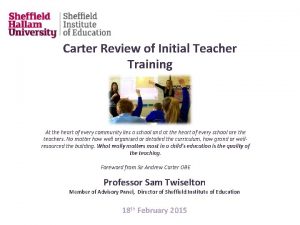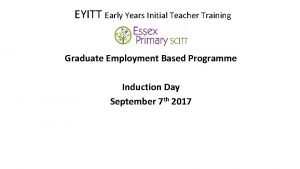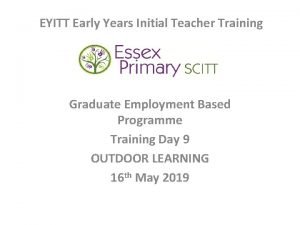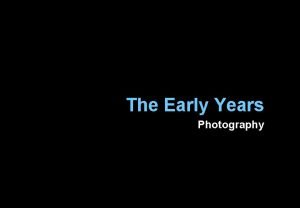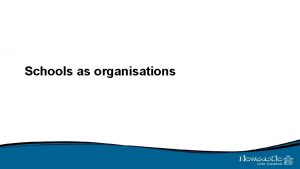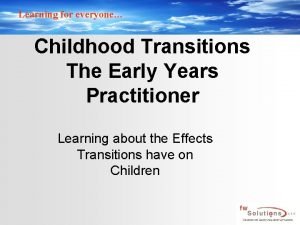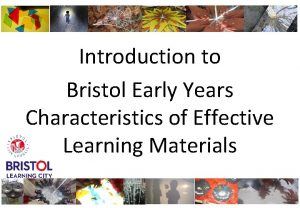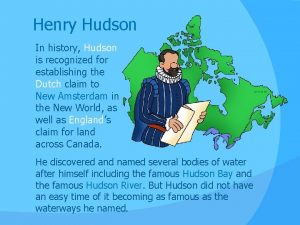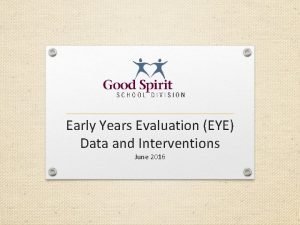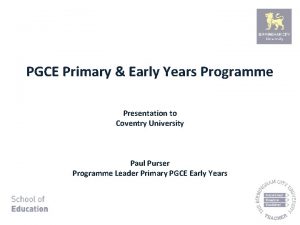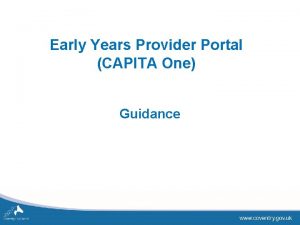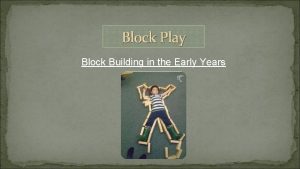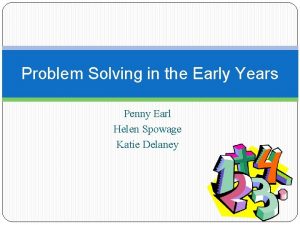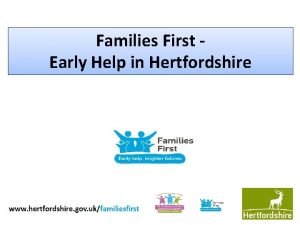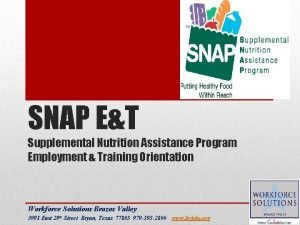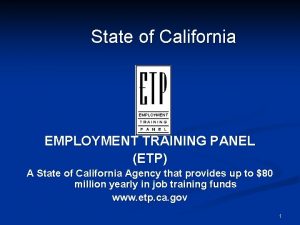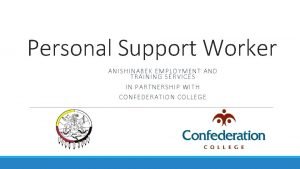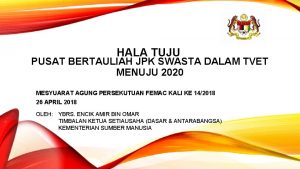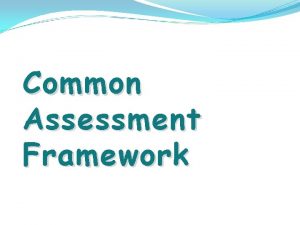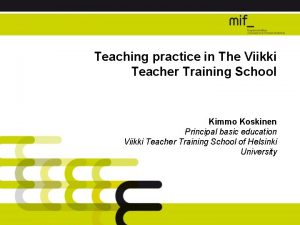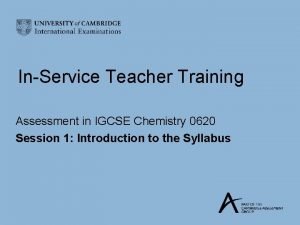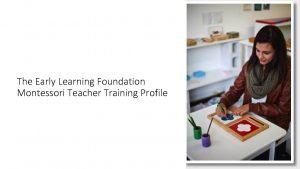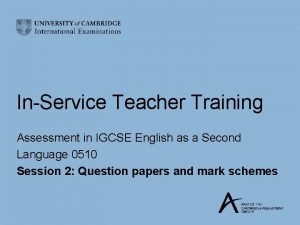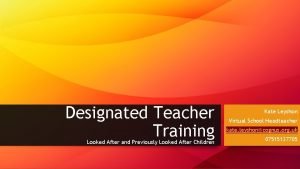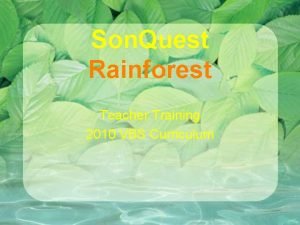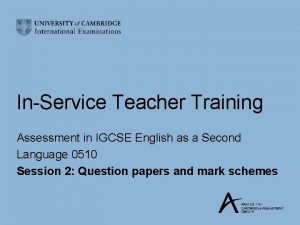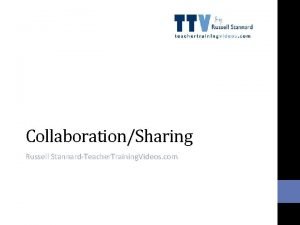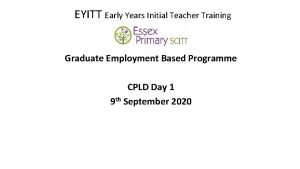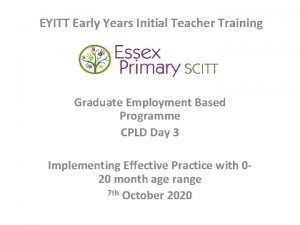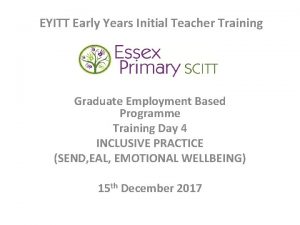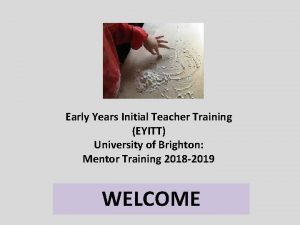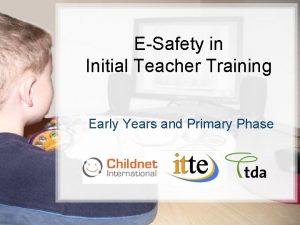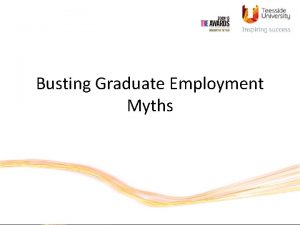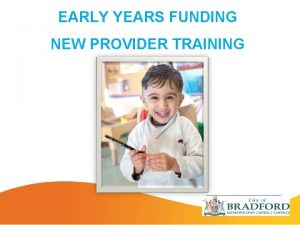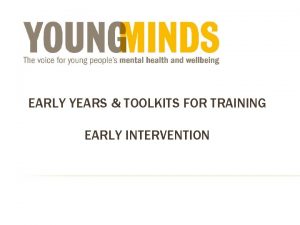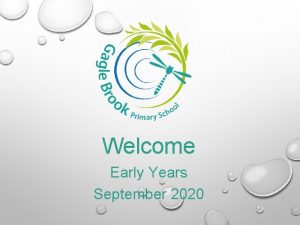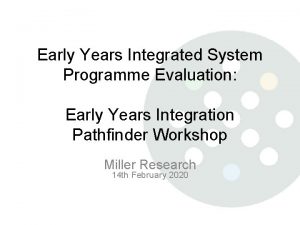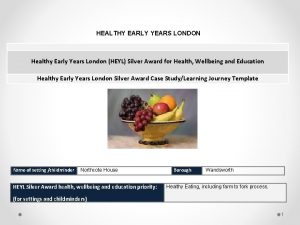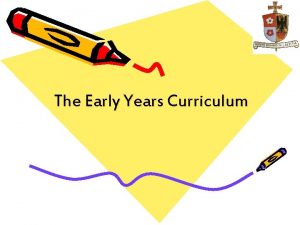EYITT Early Years Initial Teacher Training Graduate Employment
























































- Slides: 56

EYITT Early Years Initial Teacher Training Graduate Employment Based Programme Training Day 9 OUTDOOR LEARNING 16 th May 2019

Covered in this session • • • Outdoor learning – definitions and approaches Characteristics of Effective Learning in practice Forest schools Theories of outdoor learning Approaches – Loose Parts; Workshop; Boxes and Bags

Characteristics of Effective Learning in your setting • Playing and exploring (engagement). Finding out and exploring; playing with what they know; being willing to ‘have a go’ • Active learning (motivation). Being involved and concentrating; keeping on trying; enjoying achieving what they set out to do • Creating and thinking critically (thinking). Having their own ideas; making links; choosing ways to do things • Activity: discuss the picture from your setting and audit the provision with the COEL audit sheet. What pointers can you take from colleagues to improve your provision?

Forest Schools were initiated in Demark to provide a way of incorporating regular outdoor learning experiences for young children. Some guiding principles of a Forest School focus on: • Enjoying the outdoors • Capitalising on the outdoors as an area for learning • Utilising the outdoor environment as a rich source of natural materials and resources for learning • Building on how young children learn, are active, and use all of their senses to enhance their natural curiosity and motivation • Promoting and developing young children’s self-esteem, independence, confidence, positive dispositions to learning, sound skills and team work • Developing partnership with parents

Forest School in action • We have approximately 1 hour to observe a Forest School session with a year 2 class • Focus on how the Characteristics of Effective Learning are employed • How is Sustained Shared Thinking used and what is its impact? • Discuss on return and add to your COEL audit if appropriate

Outdoor learning definitions • The area immediately outside the indoor space i. e. capacity for free-flow access • The area that is not immediately outside the indoor space i. e. accessed when escorted by adults • The area that is beyond the outdoor provision for the setting i. e. different learning opportunities such as through a more natural environment • Forest School • Seashore School

Rationale for learning outdoors “the best kept classroom and the richest cupboard are roofed only by the sky” – Margaret Mc. Millan (c 1925) Nursery Schools and the Pre-school Child NSA Publication Outdoors is an equal player to indoors and should receive planning, management, evaluation, resourcing, staffing and adult interaction on a par with indoors. Children need versatile equipment and environments. Children need to be able to control, change and modify their environment “Intrinsically linked to sensory experience is emotion. . . Children need to have experiences which heighten emotions such as wonder, joy and excitement, and children need adults who will use the natural resources to bring out and develop these emotions. ” – Outdoor Play in the Early Years Management and Innovation – Helen Bilton

Outdoor Learning Through the Years Learning outdoors was, of course, the default mode for thousands of years. But it has required the persistence of many inspired educators to reaffirm its educational worth: • Friedrich Frobel (1782 -1852) promoted kindergartens with child-sized play equipment and a nature-garden focus • Margaret Mc. Millan (1860 -1931) envisaged classrooms ‘roofed only by the sky’ • Maria Montessori (1870 -1952) pioneered child autonomy and structured materials • Susan Isaacs (1885 -1948) showed how to exploit children’s curiosity as a learning tool • Marjorie Allen (1893 -1979) introduced adventure play areas and championed disability access

Dispositions Children need certain dispositions to succeed both in a learning situation and in later life. (H Bilton, 2016) • • Curiosity Creativity Resourcefulness Independence Initiative Responsibility Interest The ability to lose oneself in an activity • • Effort Mastery Persistence Challenge seeking Helpfulness Charitableness An appreciation of others efforts (Katz and Chard 1991)

Organisation (H Bilton, 2016) 3 styles of area: open, quiet and active (Walsh 1991) Learning bays might be considered: • Imaginative: a supermarket delivery depot, with trucks, large cardboard boxes, cones, plank and tables with a large number of different containers from shops. Chalk-drawn road. • Construction: partially arranged by the staff, but children to build as they wish. Also a digging plot with tools – large hole made. • Gymnasium: A-frames, planks, crates, barrel, mats, log sections, carpet squares. • Small apparatus: trolley with variously sized bats, balls, hoops, ropes. Chalks to mark out targets. • Horticulture: tools, outside tap. Plants in various stages of development, seeds to be put in. • Quiet area: chairs, cushions, carpet squares. Tree for shade. Books, drawing pads, tapes, games. • Mini-beast area: log, carpet squares, tree trunk. Cardboard squares for stepping stones. • Shed: children can easily access more resources if shed is well arranged and labelled. By the classroom wall, there is a collection of stones, pebbles and wood for use in any play.

Role of the adult • Practitioners need to plan activities and identify how adults can model, interact or play with the children when outside. • List areas of learning and development and then decide how a fixed structure will be used within it. For example, an imaginative play scene may be a pirate’s ship, and it may be thought that the climbing frame will extend this play by being made into an island. So the materials and resources are set up on the climbing frame. But another day the climbing frame may support some mini-beast project. • (Helen Bilton, Outdoor Learning in the Early Years, 2016)

Benefits and risk (as opposed to hazard) assessment Quality play provision offers all children the opportunity to freely interact with or experience the following: • Other children – of different ages and abilities with a choice to play alone or with others, to negotiate, co-operate, fall out, and resolve conflict. The natural world – weather, trees, plants, insects, • animals, mud. • Loose parts – natural and man-made materials that can be manipulated, moved and adapted, built and demolished. The four elements – earth, air, fire and water. Challenge and uncertainty – graduated opportunities • for risk taking; both on a physical and emotional level. Changing identity – role-play and dressing up. Movement – running, jumping, climbing, balancing, rolling, swinging, sliding and spinning. Rough and tumble – play fighting. The senses – sounds, tastes, textures, smells and sights. (The Toolkit, Play Wales, 2015) Undertake an initial risk-benefit assessment before introducing materials and have some basic agreements in place. Assess the materials daily. Involve the children in risk assessment – they usually make sensible suggestions. They can also advise on what needs to happen should a child’s actions give cause for concern. According to the accident logbook, there was approximately a 50% reduction in accidents and incidents of all kinds following the landscape changes and introduction of loose materials for play. (Head Teacher, Edinburgh)

Regular audits • How much time do children spend outdoors at different times of the year? Are there times of the year when children are outdoors less frequently? How easy is it for children to move between indoors and outdoors at different times of year? What are the issues for staff (such as the time spent preparing to go outdoors or concerns about mud being brought indoors)? How much shade does the outdoor space have? Is there any shelter to protect children from extreme conditions (sun, wind, rain)? Does the space include natural features, such as grassed areas, plants and trees? What impact to do these features have at different times of year? Are there resources for supporting learning in different weather conditions that are readily available to staff and children? Is there an accessible supply of suitable clothing to protect children and staff in extreme weather conditions? Discuss each of the questions above with colleagues and focus on: • What happens now? • How well it is working? • What are the factors that limit further development? Aim to identify changes and potential improvements that could enrich and extend the existing provision. • Use tools such as the Early Childhood Environment Rating Scale (ECERS) • • •

ECERS example 22. Nature/science (excellent practice) • 7. 1 Staff initiate activities for measuring, comparing, or sorting using nature/science materials (Ex: show children how to sort seashells by colour, shape, or size; arrange pinecones from biggest to smallest; chart rainfall for a month to discuss dry and wet times; predict weights of various natural objects) • 7. 2 One or more pets/plants present that children can easily observe, help care for, and that are talked about with children (Ex: classroom fish tank, hamster, gerbil; birds that are seen visiting bird feeder)

Involving the Children in the organisation • Collecting materials, grouping, choosing storage, labelling • Laminated signs • Laminated success criteria • Rules of engagement • Review of plans • Resources required • Large ongoing working wall

Lunch!

Loose Parts Play • “Accept that anything not nailed down in your playground will be used during loose parts play sessions. Picnic benches, bins, planters etc. , will all be utilised during loose play sessions by children seeking new ways to construct and design their own play spaces. Likewise ramps, slopes, railings, basketball nets and stairs will all become useful when children experiment with the play possibilities within resources. ”(Louise Caldwell, Play Development Officer, City of Edinburgh Council) • Children like disorder and some invisible order therein, most adults hate it. Children do not in the least mind being dirty. Most adults abhor it. Children and a source of enjoyment in the oddest and most unlikely play material: tin cans, milk bottle tops, broken slates, soil, cinders, firewood, the adult thinks of these things in terms of refuse and rubbish. . . (Mays, 1957: 5).

Why Loose Parts play? • Loose parts create richer environments for children to play, giving them the resources they need to do what they need to do. • Loose parts aren’t prescriptive and offer limitless possibilities. A stick, for example, may become a fishing rod near real or imaginary water, a spurtle in a mud kitchen, a tool to nudge a football that is stuck in a tree; it can be thrown, floated, snapped, pinged, bent, hidden, added to a pile, burnt, tied to something else, split, catapulted or discarded. (Loose Parts Toolkit, Theresa Casey & Juliet Robertson 2016)

Nicholson’s Theory of Loose Parts • The term “loose parts” came into use in 1971, after an architect, Simon Nicholson, published a paper called “The Theory of Loose Parts”. • Nicolson described loose parts as “variables” and provided examples such as: – materials and shapes; – smells and other physical phenomena, such as electricity, magnetism and gravity; – media such as gases and fluids; – sounds, music, motion; – chemical interactions, cooking and fire; – other humans, and animals, plants, words, concepts and ideas. • With all these things all children love to play, experiment, discover and invent and have fun.

Affordance Theory • When children play in a space or with an object they experience it in a unique way. Rather than its intended purpose, they may view it in terms of its ‘affordances’. • American psychologist James J. Gibson (1979) suggested that environments and objects within them have values and meanings that are unique to the person perceiving them. • The ‘affordances’ of an object or space are all the things it has the potential to do or be. • For example, a brick wall may be built to make a clear boundary between a pavement and a garden but for many children, it would offer a place to sit, walk along, balance, hide behind and jump off.

Loose Parts Play in Lanacshire…. .

Play themes and Loose Parts Play Adventure Seeking out the unknown, stretching limits of possibility, taking calculated risks, anticipation, discovery and invention. Becoming at home Creating space, shelter, security, hiding and secret places, refuge and territorial boundaries. Prospect Searching out high places, views and look-outs, surveying the landscape and mapping areas. Pathways and journeying The need for exploration, mapping out an area in many ways, finding short cuts and secret routes, tunnels, knowing the local area, making one’s mark in the landscape. Hunter-gatherer pursuits Searching, finding and collecting, stashing and hoarding, treasure hunts, traditional games like hide ‘n’ seek, foraging, bushcraft skills, re, tool use. Anthropomorphism Projecting self onto other living things, feelings for, and empathy with, plants and animals of all kinds, developing personal connections to wildlife through direct experience and fantasy, the significance of names. Imaginative narratives Making sense of the world through fantasy play, small world play and creating stories and accounts of experiences that connect and deepen friendships and relationships between each other and the places they play, creating memories and reaffirming order and meaning. Making rituals Deliberate, ceremonial, meaningful actions often with metaphysical or transformational intent, invented by and participated in by individuals or groups; honouring or celebrating events, places, features through art, music, dance and role play; giving and receiving

Symbolic Play • Play which allows control, gradual exploration and increased understanding without the risk of being out of one’s depth. For example using a piece of wood to symbolise a person, or a piece of string to symbolise a wedding ring.

Symbolic Play and Emergent Literacy Meaning • In literacy development, the child also must make sense out of reading, writing, and language. The very process of play (assimilation) is the basis for constructing one’s own reality –in other words, “making meaning”. As a child plays with his environment, he is able to abstract meaning from objects and represent them symbolically. As a child plays with language and letters, he is also able to abstract meaning from them and use them symbolically. Language • From Vygotsky’s viewpoint, symbolic play is essential to the development of language because it provides the means for the development of representational thought. The child is able to use the word “chair” as a symbol for the object and can do so with meaning attached. • *Symbolic Play and Emergent Literacy Sandra J. Stone William Stone

Block Play • There is evidence linking good spatial skills and children’s future achievement in all the STEM (Science, Technology, Engineering and Mathematics) subjects (Lubinski 2013; Newcombe 2010). • Start with giving children ample time for openended exploration with blocks. • To see children’s spatial thinking flourish, target the spatial skills and offer block activities that encourage spatial language and challenging tasks.

I made a unicorn….

Workshop approach • • • • Range of ‘real’ everyday objects, accessible and well organised Using ‘real’ tools Use tools to deconstruct Autonomy of what is being made or line of investigation – creating your own problems Supporting schemas through tinkering/repetition Exploring representation/abstract Exploring narrative by discussing process, recall and storytelling Emerging mark making in design phase Critical thinking – how it works, analysis Creative thinking – what are the properties and how can they be use? Analysis and reflection. WWW/EBI Higher order thinking – lots of opportunities to pause, stand back, trial, resolve Many opportunities to use SST Many opportunities for CCT – spaces that enable children to try and fail; rehearsal of trial and error; cognitive load theory (Sweller) – open-ended resources provide more opportunities with ambiguity and practical problem solving supports long term memory and the ability to transfer skills to a variety of contexts

Creativity Four steps in the creative process Preparation • This step involves exploring and looking for the real problem. This can include gathering information, finding available resources, and getting acquainted with the problem or issue. Incubation • During this step, the problem is not considered; instead there is a period of abstinence from mental work. Illumination • This is often described as the moment of “Aha!” or “eureka!” A new idea or combination appears that meets the requirements of the problem. This step is also referred to as the “light bulb” effect. Verification • At this time, the solution is tried out to determine whether the idea will work.

Creativity Four components of the creative process Originality • The idea that is truly unique. It is not like any other product; it is a one-ofa-kind idea. Fluency • The generation of many different ideas. The emphasis here is on the number of ideas produced. Flexibility • The ability to change direction or think in another way. Elaboration • Taking an idea and expanding it to make it more intriguing and complex. • This applies to your outlook too!!

Examples of resources in a workshop (depending on age of children) • • Variety of fabric, needles, wool, cotton Buttons, ribbons, string, beads Variety of fixings Hammers, nails, sandpaper, balsa wood, safety glasses Clothes patterns Range of natural materials Old clocks, tape recorders, radios etc. Clay, paint, oats, sand, salt

Examples of themes • • • Shoemaker Mechanic Sculptor Dressmaker Architect Furniture designer

Peter Moorhouse and woodwork…. .

Continued….

Continued……


Play boxes/bags • Critical thinking – a bag with seemingly unrelated objects • Story bag e. g. for our bear it might contain a torch, a blanket, a sleep mask, a thermometer, a calendar, a diary, a clock, a map • Heuristic play theme – everyday objects • Loose parts • Who is the mystery owner? – train ticket, purse, glasses, diary, food wrapper, other personal effects • The artist • The musician • The time traveller

Thinking outside the box Place a collection of boxes in the middle of the class circle. Discuss the cardboard boxes that you have brought. Include questions, such as these: • What might have come in the box? • How did the box get to your house? • What could you put in the box? • How would you use a box? • Brainstorm a list of ideas with the children. • Pose the question, “What could you create if you used two boxes together? ” • Ask the children to sketch their ideas on paper. • Place boxes and various containers in different areas, indoors and out for the children to construct their ideas in three-dimensional form.

Boxes and bags Play boxes/play bags/prop boxes contain exciting resources that support a particular theme/topic/story/event. They can be used alone or with equipment that you already have outdoors. Play boxes/bags need to be labelled and organised in a way that is accessible to the children. The Rainy Day Box • Raincoats • Wellies • Umbrellas • Plastic bottle ‘rain gauges’, jugs • Watering cans • Waterwheels • Photographs of rain • Chalks to draw around puddles • Guttering • Objects to float • Paint brushes • Tin trays The Windy Day Box • • Streamers • Kites • Windmills • Plastic bags • Yachts • • Windchimes Sunny Day Box • Sun hats • Caps • Sun cream (pretend) • Sunglasses • Sun Umbrella • Chalk to draw around shadows Frosty/Snowy Day Box • • Hats • Scarves • Gloves • Thermometer • Spades • Tin Trays The Beach Play Box • Beach towel; Beach mat; Beach ball; Beach bag • Buckets and spades • Paddling pools • Sun cream bottle (empty) • Sun glasses • Sun hats • Shells and pebbles • Flip flop or ‘jelly’ shoes • Fishing nets • Sea creatures • Boats • Pretend ice-creams • Punch and Judy puppets The Painter and Decorator’s Play Box • Assorted sizes of brushes and rollers; Roller trays; Rolls of wallpaper and border rolls; Paint • Buckets • Tape measure • Mobile phone • White overalls or old shirts • Sponges • Clipboards • Paint colour cards Washday Play Box (use a wash basket) • • Bowl • Washing powder/liquid; Fabric conditioner • Clothes of various sizes; Washing line; Wash basket; Pegs • Ironing board • Clothes horse • Old fashioned wash board

Bags The notion of having a bag of materials arranged to suit topics or subject area fits in with developing an outdoor classroom. The bags are bought inexpensively and filled by staff who are aware of potential learning outcomes from the resources. SIZE/QUANTITY • Mini clipboard and writing implements, suitable story book and appropriate maths story • Pebbles • Glass shells • Carpet squares • Small, medium and large boxes • Leaves • Glass fish MEASURES • Mini clipboard and writing implements, suitable story book and appropriate maths story • Sticks • Carpet squares • Tape measures • Wool, thread, string, cord and scissors • Rulers • Ribbon

Final activity • The den building challenge • In your group select a range of materials on offer to build a den for teddy in the Forest School area • You must ensure that you take account of teddy’s specific needs • Consider how symbolic play is used • Consider how SST is used • Which Early Learning Goals can you assess from this exercise?

To read at your leisure…….

General Outdoor Provision During Winter • • • In Autumn encourage the children to collect natural materials, ready to store and use e. g. conkers, leaves (including skeletons); sticks; dried grasses Create a well-organised transition area for changing into winter weather clothing that encourages independence. Add pegs and baskets to allow the children to replace items once used. Build a compost heap. Growing area: - harvesting winter vegetables such as brussel sprouts, turnips, swedes, leeks and parsnips. Planting: - winter onions ; garlic cloves can be sown around December/ January; in February sow early peas, beetroot, spinach Create a mini-beast hotel/habitat tower Seed cakes or feeders Take a picture of your outdoor space from the same position every season and compare the differences Snack outdoors Winter watch reference cards/posters etc.

Taking a theme • • • Hibernation Shelter building A particular story Journeys Areas to promote critical and creative thinking A particular approach e. g. Heuristic play (Heuristic play describes the activity of babies and children as they play with and explore the properties of ‘objects’. These ‘objects are things from the real world. Elinor Goldschmed); Robertson) Loose Parts Play (Toolkit by Theresa Casey and Juliet

Hibernation • Post this as a knowledge challenge (possibly in their talk partners) for a couple of days • What do we know? • What can we find out? • How many words can you find in this word? • Have a working wall – section for each pair? • Present how they wish (including verbally, adult can scribe). • End game is to build a shelter but don’t rush – lots of investigation in between!

Springboard for each area of learning • • Communication and Language Personal, Social and Emotional Development Physical Development Reading Writing Mathematics Expressive Arts and Design Knowledge of the World

Communication and Language Activities • Talk partner challenges • Retelling a story • Recall • Prediction • Active listening • Negotiation • Adaptation Critical and Creative Thinking • Thinking out loud (adult model/adult scribe) • Practise the ‘how do you know? ’ Resources • Open-ended natural/everyday materials/objects • Themed bags and boxes • Large working wall • Wallpaper and recording materials • Squared paper • Post-its • Recording equipment • Cameras

Personal, Social and Emotional Development Activities • Cardboard Teddy challenge • How to care for themselves during winter • How to care for other animals in winter • Working in pairs and in a group • Whose birthday will be missed during the hibernation period? • Which festivals will the hibernating animal miss? Critical and Creative Thinking • How can I test if my own idea will work? • How can I test if someone else’s idea will work? • Can I show perseverance and independence? • Can I explain why I think something happened? Resources • Clothing box containing a range of hats, scarves, gloves, bits of material • Card • Fixings e. g. treasury tags, glue etc. • Shelter materials • Materials to test out for Teddy’s clothes/shelter e. g. cling film; foil; felt; cotton; plastic; sandpaper; paper • Calendars

Physical Development Activities • Use a range of resources to encourage pushing/pulling; squeezing; pinching; twisting; flattening; transporting etc. • Learn how to tie knots • ‘Sometimes I like to Curl up in a Ball’ • The Hibernation Boogie • Journeying to and from shelter points by balancing, locomotion, tracking • Create different modes of transport for The Jolly Postman to reach hibernation shelters • Explore large scale construction for modes of transport to reach where birds have migrated to Critical and Creative Thinking • What effect will this action (e. g. twisting) have on this material? • What is the best material to balance on and why? • How can I interpret music/story into movement? Resources • Transparent plastic jars with lids • Pegs • Tweezers • Crates • Sturdy bread baskets • Laminate flooring • Variety of safety mirrors • Plastic shower hooks • Plastic piping with joints and fixings • String/ribbon

Reading Activities • Ongoing use of Hibernation working wall • Clues for the journey when going on a bear hunt • Glow in the dark signs • Fiction/non-fiction materials in every area • Laminated scribed pictures of children/processes around every area as a success criteria • Explore use of colour in warning/information signs • Hot-seating interviews for missing animals – conducted outside for accurate context • Reading for a purpose throughout the investigation: – Signs outside shelters – Instructions for caring for an animal – Tickets for a journey – Travel brochure for a migrating bird – Hibernation shopping list – My first breakfast as a hungry…… Critical and Creative Thinking • What strategy can I use to deduce meaning? • What is the purpose of me reading this? • Who/what will help me? • How can I do this on my own? Resources • Springboard texts • Signs created by staff and children • Laminated alphabets with pictorial clue • Magnifying glasses • Binoculars • Range of glasses • Coloured cellophane • Danger/keep out signs

Writing Activities • Travel brochure for the migrating bird • Use laminated white card for a variety of signs and labels • Hibernation list • The eve of hibernation – menu for the jolly postman at each shelter • Lyrics for the hibernation boogie (inspired by ‘Sometimes I like to curl up in a ball’) • Journey plan for the Jolly Postman to reach the shelters • Bear cave markings • Labelling plans for the shelter • Adding to the working wall • Glow in the dark bear cave posters/magazines/labels • Investigate materials that are good for writing on outside and will withstand the weather • Investigate how to write with unusual apparatus such as squeezy bottles etc. • Messages from friends who won’t see you for a while • Snore score – investigating sound and nonsense words , particularly good linked to phonics • Missing animal posters Critical and Creative Thinking • What is the best way to represent this information? • What does this writing genre physically look like? • Am I more comfortable writing vertically, horizontally, on the ground, on a surface? • Can I make a mark with this and what is the effect? How can I modify this? Resources • Wallpaper • Rollers • Buckets • Brushes • Laminated blank card • Pens • Glow in the dark pens and paint • Implements to scratch into soap, polystyrene, wax • Tracing paper • Safety mirrors

Mathematics Activities • Investigating pulleys to transport winter stores • Positional language for teddy and hibernating animal • Calculate the rough size of the shelter to accommodate your hibernating animal – explore how many people will fit through den building • Measure size of footprints in mud/snow (real or otherwise) • Plot how many days your animal will be hibernating for – whose birthdays will this cover? Which festivals will they miss? • Use a variety of scales to measure out food for the shelters. Investigate which animal’s food is the heaviest. • Investigate direction/maps when plotting a journey for The Jolly Postman to visit – make road signs indicating number of steps, strides, planks to a certain point • Outline puddles in chalk and plot whether it still fills the outline after an hour/by snack time/lunch time – do the same with a frozen patch. • Submerge a variety of different sized containers and explore rainfall • Create a range of laminated equipment use success criteria e. g. how to use scales • Investigate den building using a variety of materials and fixings Critical and Creative Thinking • How can I test out this theory? • What is the best equipment for the job? • How do I know I’m using this equipment correctly? Resources • Sticky plastic hooks • Shower curtain hooks • Shelter materials • Scales – standard and child-made • Tape measures • Lengths of large squared paper • Laminated card • Rounder's posts • Calendars • Diaries • Laminate flooring • Different sized laminated footprints • Foam • containers

Expressive Arts and Design Activities • Waterproof Christmas decorations for trees, bushes or fencing • Explore the work of artist Andy Goldsworthy • Explore the work of Henri Rousseau for camouflage (to help to keep your hibernating animal safe) • Add food colouring/washing up liquid to puddles • Design a sleep mask and quilt for your hibernating animal, using natural resources • Use a variety of outdoor surfaces to investigate cave drawings, using a variety of substances to mark make with e. g. edible berries • Create the Snore Score using a variety of resources • Hibernating animal role play sack/box • Walking like a……… • Live weather composition • Scraping, banging, scratching – small and large resources to investigate sound linked to hibernating animal’s dream • Dream catchers in shelters and in different places in outdoor area Critical and Creative Thinking • What effect does this weather have on this resource and why? • What can I use that will best represent a design, sound, story? • How can I change how this behaves? Resources • Clingfilm • Plastic • Shower curtains • Bark • Breeze blocks • Wall/tarmac • Wallpaper • Sandpaper • Dried grasses • Leaves • Mud • Natural paint • Range of different size footwear e. g. wellies, slippers, boots • Pipes, flip flops and ping pong bats • Wooden spoons, pasta servers, plastic colanders etc. • Bendy piping • Oats/sawdust

Knowledge of the World Activities • Investigate a variety of habitats and include a ‘signs of life’ tour • Suitable materials washing line • Include life underground by installing a wormery • Submerge a variety of containers (cover at night with fine chicken wire) and check for signs of life • Where in the world have you gone? Tracking the travel blog of the migrating bird • Investigate light and dark and glow in the dark materials as well as light sources – creating somewhere dark outside • Investigate den building with a variety of materials to see which is best at combating which kind of weather • Investigate which animals hibernate and in which country in the world • Investigate nocturnal animals and what are the signs to look for in the outdoor area? • Use a night camera if possible • Use Winter watch materials for signs/advice • Sort natural materials into categories like tickly, prickly, furry • Use equipment outdoors to record sound/pictures • Use den materials to explore the sound of the elements e. g. raindrops on a corrugated plastic roof • Plastic bag kites Critical and Creative Thinking • What effect is this weather having on this material? • How does this work? • What are signs of life and how do we sustain it? • What do I need to change to make this work better? Resources • Reflective materials • Luminous materials • Torches • Glow in the dark pens and paints • Plastic containers of varying sizes • Maps • Binoculars • Magnifying glasses • Cameras/recording equipment

Shelter materials Natural • Sticks • Leaves • Porridge oats/sawdust • Dried grasses/hay • Straw • Bark • Logs • Trees/bushes Man-made • White shower curtains • Duvet covers/blankets/curtains • Pegs • Laminate flooring • Tarpaulin • Chairs • Carpet • Boxes, varying sizes • Corrugated plastic sheeting

A note on Schemas • Schematic play roughly falls into the following areas: • Transporting -Moving resources and self from place to place • Enveloping - Covering themselves or other items • Trajectory (straight lines) -Learning about movement of things and self in vertical, horizontal and diagonal lines, still and in motion • Rotating (circles) - Exploring things that turn, including self • Connecting - Joining and separating • Enclosing - Surrounding self, objects or space with a border • Containing - Putting self or things inside other objects • Positioning - Placing objects or themselves in particular places • Dabbing - Random or specific marks Include in your discussions with parents before the child starts • Transforming - Exploring changes school Include in your observations of the child Include in your review of the provision

References 1. 2. 3. 4. 5. 6. 7. 8. 9. Outdoor learning in the early years. Helen Bilton (2016) Creativity and the arts with young children, 3 rd edition. R. Isbell, S. Raines (2007) Wadsworth, Cengage Learning The Toolkit, playwales. org Loose Parts Play, by Theresa Casey & Juliet Robertson (2016) Engaging Children’s Minds: The Project Approach. Katz and Chard (1995) Early Childhood Playgrounds. Planning an Outside Learning Environment. P. Walsh (1991) ECERS (3 rd Ed). T. Harms, R. Clifford, D Cryer (2015) Theory of Affordances. The Ecological Approach to Visual Perception. J. Gibson (1979) Theory of Loose Parts. An important principle for design methodology. S. Nicholson. (1971)
 Eyitt course
Eyitt course Carter review of initial teacher training
Carter review of initial teacher training Eyitt
Eyitt Eyitt
Eyitt Eyitt jobs
Eyitt jobs Eyitt
Eyitt Banegas initial english language teacher education download
Banegas initial english language teacher education download Sheep years to human years
Sheep years to human years 300 solar years to lunar years
300 solar years to lunar years How long is four score years
How long is four score years Early years of william shakespeare
Early years of william shakespeare Early years photography
Early years photography Summarise types of early years provision
Summarise types of early years provision Medway early years
Medway early years Effects of transitions in early years
Effects of transitions in early years Bristol early years characteristics of effective learning
Bristol early years characteristics of effective learning What is henry hudson famous for
What is henry hudson famous for Hampshire services for young children
Hampshire services for young children Eylf meaning
Eylf meaning Eye early years evaluation
Eye early years evaluation Developmental milestones 20-40 years
Developmental milestones 20-40 years Pgce early years
Pgce early years Glasgow counts early years
Glasgow counts early years Coventry early years portal
Coventry early years portal Block play early years
Block play early years Picasso early life
Picasso early life Mark making eyfs
Mark making eyfs Partnership working in early years
Partnership working in early years Penny earl and mark
Penny earl and mark Families first assessment
Families first assessment Early years summit
Early years summit Nottingham city early years
Nottingham city early years Early years foundation stage pack
Early years foundation stage pack What does abawd mean
What does abawd mean Employment training panel sacramento
Employment training panel sacramento Anishinabek employment and training services
Anishinabek employment and training services Gila river employment and training
Gila river employment and training Hala tuju tvet
Hala tuju tvet Osha hazard communication inital training
Osha hazard communication inital training Early cpr and early defibrillation can: *
Early cpr and early defibrillation can: * Erf meaning
Erf meaning Good evening students
Good evening students Professional development program rockefeller college
Professional development program rockefeller college Caf education
Caf education Viikki teacher training school
Viikki teacher training school Nature of formative evaluation
Nature of formative evaluation Fsaa datafolio
Fsaa datafolio Elf montessori
Elf montessori Igcse teacher training
Igcse teacher training Designated teacher training
Designated teacher training Vbs teacher training
Vbs teacher training Viikki teacher training school
Viikki teacher training school Igcse teacher training
Igcse teacher training Igcse teacher training
Igcse teacher training Russell stannard teacher training videos
Russell stannard teacher training videos Training is expensive without training it is more expensive
Training is expensive without training it is more expensive Metode of the job training
Metode of the job training

